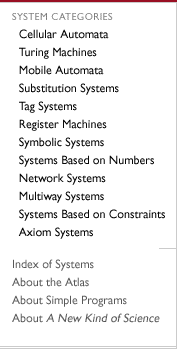|
About the Atlas of Simple Programs
The Wolfram Atlas of Simple Programs charts the computational world
introduced in Stephen Wolfram's A New Kind of Science. Much like
the
atlases of another age of exploration, the Atlas both documents
what has
been uncovered, and defines entryways into the unknown.
Also like its spiritual predecessors, the Atlas is primarily
visual. The
irreducible complexity present in even the simplest of systems cannot be
accurately characterized by a small set of numbers or equations--and
attempts to do so will filter out potentially interesting behavior. The
Atlas therefore strives to present all information about a system's
behavior as directly as possible--typically by using pictures.
In addition to the definition and evolution of systems, the Atlas
maintains a list of simple and general questions relevant within a class
of systems. These questions are then answered for each class member to the
extent the Atlas's resources allow. In a specific case this answer
may not
seem immediately interesting. But unless one in effect already knows what
to look for, working within this kind of systematic framework is the best
way to discover new phenomena. For among other things, the ability to
quickly absorb large quantities of data and evaluate simple hypothesis
builds one's intuition. Having developed a greater sense of context, it is
possible to return to a property initially dismissed and find in it some
new and unexpected behavior.
The simple, systematic analysis generated by the Atlas is intended
to
promote the methodology of A New Kind of Science. But specific
systems
naturally lead to their own questions, and so the Atlas is also
designed
to document these important diversities. This aspect of basic science is
an ends in itself, but it also builds a foundation which traditional
science, and society in general, can connect with and build on. For much
as the traders and settlers built on the details of trailblazers'
accounts, those in science and elsewhere will apply the concrete results
in the Atlas to further their own interests. And as the quantity of
specific details grows, general principles will emerge and then diffuse
into all areas of human activity.
Ultimately, the Atlas is more than just a database of knowledge
about
simple abstract systems. It is an experiment in building 21st century
scientific communities. Despite having to go against the grain of three
hundred years of science, NKS finds itself with a unique advantage: its
objects of study exist natively in computers. For a start, this basic
requirement is vastly more commonplace than the sophisticated technical
knowledge prerequisite of established science. But perhaps more important
in the long run is the fact that each NKS practitioner can communicate
discoveries with very little overhead. Less bias need be exercised in
choosing what to prepare for publication, and knowledge that would
otherwise be locked away and forgotten may inspire another's contribution.
Furthermore, the fact that each idea can exist independently of some
cobbled-together structure means it is easier to understand, reuse, or
investigate more deeply.
A curious aspect of NKS is the frequency with which it informs its
surrounding meta-issues. The ideas behind the Atlas are certainly
one
example. As a consequence, the Atlas and its sister initiatives are very
much in the same historical state as the main thrust of NKS--endowed with
good, general ideas, but needing detail and execution. So the sooner an
active community starts using and contributing to it, the sooner it will
be possible to identify and address the questions and issues the Atlas's
own evolution raises.
Kovas Boguta
Wolfram Science Group
Read also about the technology of the atlas.
| 